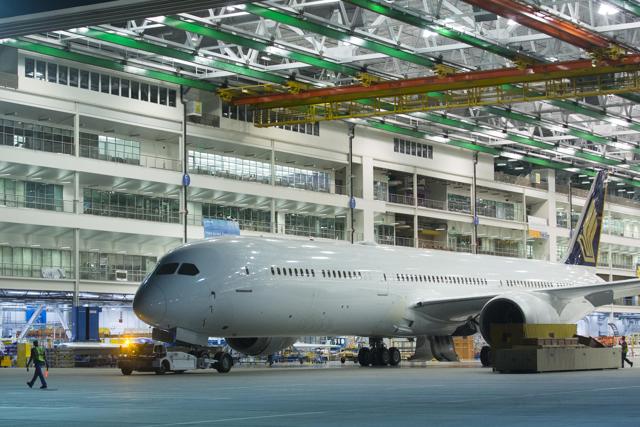The Boeing (BA) 787 program is likely one of the most watched commercial aircraft programs from a cost perspective for Boeing. During 2017, the program saw some key events with the first flight of the Boeing 787-10, the biggest variant of the Dreamliner program, orders from key customers and a long awaited extension of the accounting block.
Changes to the accounting block were made in the 3rd quarter of 2017. Over the past few quarters, AeroAnalysis has contacted Boeing several times to exchange thoughts and views and that has allowed us to quite accurately model the deferred balance development. In the 3rd quarter of 2017, Boeing extended the accounting block by 100 aircraft. A block extension was what we have been expecting for a while, but we expected Boeing to announce an extension of 200 units instead of the 100 units.
In order to accurately model the impact of the change, we reached out to Boeing to ask what the deferred balance would have looked like without the impact of the block extension. This is a figure that it did share during a previous earnings call when it reclassified part of the cost balance to R&D costs. This time, Boeing has been unwilling to shine some more light on this except for mentioning that the block extension is accretive to the program margin.
Boeing gave no information that AeroAnalysis wasn’t familiar with already, and that"s unfortunate, especially since the articles we publish on Seeking Alpha on the deferred balance subject are important for Boeing investors, are somewhat unique, and have a very appreciable accuracy.

Source: The Boeing Company
In this report, we will have a look at what our expectations are for the performance in the 1st quarter and the delivery balance at the 1,400th delivery. We think it is very useful to do so, as it gives an idea of Boeing"s ability to generate certain profits on production, the ramp-up pattern of those profits and whether there is a need for charges in the future based on current expectations. This report is in addition to the report that we already wrote on the our expectations for the first quarter based on past performance. While this report does also include a projection for the first quarter, the calculation method is significantly different.
Additionally, this is one of the few moments where you get a "peek in the kitchen". Once the balance is zeroed out, it is unlikely that Boeing will quantify anything on the Dreamliner program other than backlog, deliveries and production, and you will have no clue about cash generation on the program.
Understanding and gaining understanding of program accounting and the development of the deferred balance is very important. An example demonstrating this: At the start of 2016, Boeing shares sank on the announcement of an SEC probe that would focus on the program accounting method on the Boeing 747 and Boeing 787 programs. Although this potentially could harm Boeing, we viewed the drop in share prices overdone, and it likely was the result of investors being unfamiliar with program accounting and alternatives to recognizing charges. Any investor who bought on "the dip", which was almost a no-brainer, has seen their investment pay off pretty well with a >200% return. Aerospace isn"t "sexy" to invest in compared to tech and certain other areas and might not be as rewarding as biotech, but if you know what you are investing in and are able to put certain subjects in a bigger context, then it can be very rewarding.
Since not all of my readers are familiar with the program accounting method and program accounting on the Dreamliner program, we have provided a brief overview below.
Program accounting

Source: Steemit
Boeing uses program accounting for its aircraft programs instead of unit-cost accounting. To understand what the deferred costs are, it is important to know how program accounting works. On programs where initial production costs are high, such as aircraft programs, it does make sense to amortize costs over a wider number of productions than just on the few initial productions. In other words, costs are spread out over an accounting block, and it is not only the costs that are spread out. Boeing makes assumptions on the revenues as well. For the Boeing 787 program, the accounting block currently stands at 1,400 units, up from 1,300 and 1,100 units previously.
Boeing says that the units in the accounting block are units of which it can credibly estimate costs and revenues but should not be considered an indication for a break-even point. Unless Boeing has set an average program margin of 0%, which it has not, a zero deferred balance is no indication of a break-even point. Analysts pay close attention to the deferred balance and so should investors. The reason is that it is likely Boeing needs to recognize a charge if it has not zeroed out the deferred costs by the 1,400th delivery (the number of units in the accounting quantity).
Simultaneously, one should be aware of the fact that if Boeing zeroes out its deferred balance by the 1,400th delivery, it will actually have made the profits that it estimated for the accounting block and that the profits it has been reporting for the program were valid after all. So, the 1,400-unit accounting block is far from a break-even point. Even if Boeing does not zero out the balance by the last delivery and has to recognize a charge it can still have booked a profit if the recognized charge is lower than the realized program profit.
The assumption for costs and revenues means that Boeing assumes an average profit figure for each of the aircraft it currently delivers. If the actual profit figure is lower than the assumed profit, the deferred balance rises. If the profit is higher than the assumed profit, the deferred balance declines. So, the deferred balance tells you how profitable or unprofitable the program has been to date versus the assumed program profits.
Change to the model
The total balance that Boeing needs to recoup on the Boeing 787 program consists of 2 sub-balances. The first one being the deferred production balance and the second one being unamortized tooling costs and other non-recurring costs. In previous modeling attempts we always considered the deferred production balance only, assuming that Boeing would first build off the deferred balance and after that start reducing the unamortized tooling costs. This assumption was nothing more than an assumption to simplify the calculation process. We now have lumped both balances, since it is more important to be able to assess the overall improvement rather than being able to attribute performance to either of the balances. Additionally, the ramp up pattern has been flattened somewhat since we previously overstated the improvement by $153 million to $367 million. This is just 1.5% of the deferred production balance, but given that in absolute figures we are talking about several millions per airframe and the fact that the model used to estimate the balance within a 1% margin and often within a .5% margin we deem a 1.5% deviation to be too high and it could even make the difference between having to recognize charges and extending the accounting block or not.
A change that is not yet implemented in the automated calculation model is an additional margin improvement as Boeing saves money on titanium and steps up its production in 2019. A column has been manually added to highlight expected savings.
First quarter estimate and full block estimate
For the first quarter a decrease of roughly $1B is expected according to our modeling. There are a few things important to observe. The first thing being that just like in previous modeling attempts, the deferred production balance can possibly be zeroed out within 1,400 deliveries. The model suggest that roughly $600 million would remain uncovered from the deferred production balance with the remainder coming from the unamortized tooling costs and other non-recurring items. That is something that hasn’t changed much, since we have always pointed the latter balance to be making the process of zeroing out the costs within the accounting quantity more challenging.
The combined balance is expected to remain at $3.76B at the 1,400th delivery. As pointed out before, Boeing has some cost initiatives running that would further reduce costs but these have not been fully modeled. We expect further savings coming from additive manufacturing as well as a rate increase in 2019. Assuming that these are all additional savings on top of a more favorable delivery mix and maturing profits, Boeing could zero out the complete balance as the additional savings could potentially fully offset the remaining balance.
In case, no additional savings are to be realized, then Boeing would most certainly need another block extension.
Gliders

Source: ch-aviation
Due to in-service issues with the Rolls Royce Trent 1000 Package C, deliveries of RR powered Boeing 787s are running late on top of existing delays as Leeham News and Comment reported. This will likely cause a build up in inventory, which might affect the burn off of the total deferred balance.
Conclusion
In this report we have lumped the deferred production balance and unamortized tooling costs. As a result, the expected balance after all units within the accounting quantity has seemingly increased to $3.76B up from a figure close to zero. This is mainly caused because we have now included the unamortized tooling costs in the total balance, whereas we previously only mentioned it at the end of the article.
Quite important to note is that at the 1,400th delivery we do not expect Boeing to have completely zeroed the balance unless additional savings as previously outlined indeed do materialize. In absence of these savings, another block extension will be required.
For investors, we currently see no reason to worry about the Dreamliner long term challenge to zero out the deferred balance and we currently think the Dreamliner is nicely boosting Boeing’s free cash flow and we expect the same for the first quarter. For Boeing it remains key to keep the delivery stream going and that is something that has proven to be difficult in recent weeks as also the Boeing 787 is coping with issues on the turbofans.
If you enjoyed reading this article, don’t forget to hit the Follow text at the top of this page (below the article title) to receive updates for my upcoming articles.
Disclosure: I am/we are long BA.
I wrote this article myself, and it expresses my own opinions. I am not receiving compensation for it (other than from Seeking Alpha). I have no business relationship with any company whose stock is mentioned in this article.
No comments:
Post a Comment